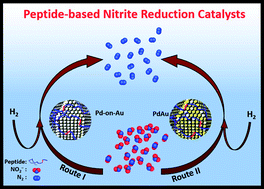Peptide-directed Pd-decorated Au and PdAu nanocatalysts for degradation of nitrite in water†
Abstract
In this work, a palladium binding peptide, Pd4, has been used for the synthesis of catalytically active palladium-decorated gold (Pd-on-Au) nanoparticles (NPs) and palladium–gold (PdxAu100−x) alloy NPs exhibiting high nitrite degradation efficiency. Pd-on-Au NPs with 20% to 300% surface coverage (sc%) of Au showed catalytic activity commensurate with sc%. Additionally, the catalytic activity of PdxAu100−x alloy NPs varied based on palladium composition (x = 6–59). The maximum nitrite removal efficiency of Pd-on-Au and PdxAu100−x alloy NPs was obtained at sc 100% and x = 59, respectively. The synthesized peptide-directed Pd-on-Au catalysts showed an increase in nitrite reduction three and a half times better than monometallic Pd and two and a half times better than PdxAu100−x NPs under comparable conditions. Furthermore, peptide-directed NPs showed high activity after five reuse cycles. Pd-on-Au NPs with more available activated palladium atoms showed high selectivity (98%) toward nitrogen gas production over ammonia.



 Please wait while we load your content...
Please wait while we load your content...